Mobile Ivy Bridge and ASUS N56VM Preview
by Jarred Walton on April 23, 2012 12:02 PM ESTIvy Bridge: Much Faster Quick Sync and 3DMark Performance
We’ve looked at a bunch of general application benchmarks, but there are two areas where Ivy Bridge really looks to improve on Sandy Bridge: Quick Sync and the integrated graphics. How important these two items are really depends on how you plan to use your laptop. If you’re only going to surf the web, watch some YouTube/Hulu/Netflix streams, and work in Microsoft Office applications, many of the improvements in Ivy Bridge won’t really matter. If you might play some games or convert and upload videos to YouTube, however, these last two improvements represent the biggest change relative to Sandy Bridge.
We’ll start with the video encoding tests, using ArcSoft MediaConverter 7 and CyberLink MediaEspresso 6.5. We’ve looked at both utilities in the past, and while there are some minor changes the basic goal continues to be simplicity of transcoding videos. If you’re after maximum quality video transcoding, you’re not going to beat CPU-based utilities using fixed function encoders like Quick Sync. Instead, Quick Sync is all about speed, and sacrificing a bit of quality in order to get your videos converted faster is considered an acceptable tradeoff.
MediaConverter 7 doesn’t give much in the way of options, so we tested with CPU-based and GPU- or Quick Sync accelerated encoding. For all tests, we used GPU accelerated decoding, as disabling/enabling this feature didn’t appear to affect quality or performance much and by default it’s enabled. MediaEspresso has a few more options, depending on how you’re doing the transcoding. For CPU-based and Quick Sync encoding, you can choose between speed and quality for the transcode; for NVIDIA or AMD GPU encoding, you don’t get a choice—we assume here that the encoding for AMD and NVIDIA GPUs is more or less equivalent to the “Faster” encoding setting of the CPU/Quick Sync encodes. Here are the three charts showing performance of dual-core Sandy Bridge i5-2520M, quad-core Sandy Bridge i7-2820QM, quad-core Ivy Bridge i7-3720QM, Ivy Bridge with the GT 630M active, Llano A8-3500M, and Llano A8-3500M with GPU-accelerated encoding.
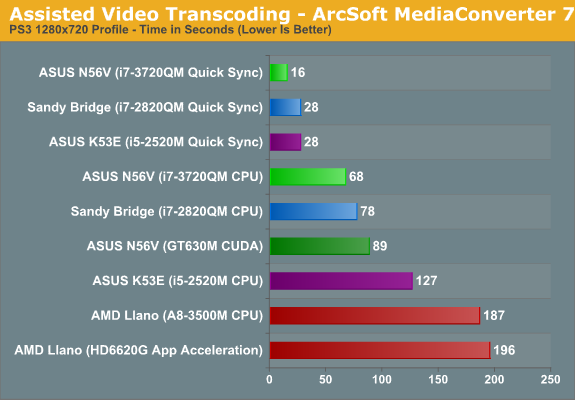
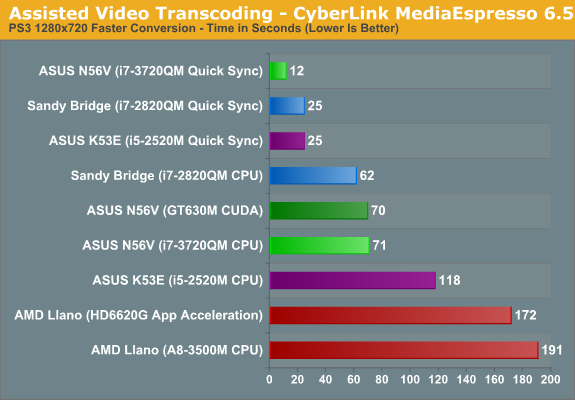
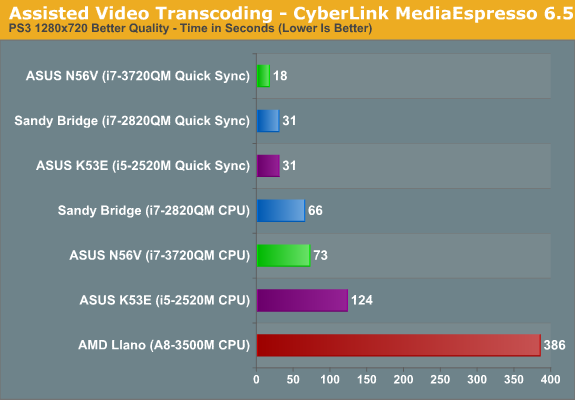
First things first, either AMD’s GPUs don’t handle this sort of task very well, or MediaEspresso and MediaConverter aren’t at all optimized for AMD’s GPUs—or at least they need far more than the 400 GPU cores in the HD 6620G. AMD has their VCE (Video Codec Engine) in Southern Islands, but so far we have yet to see a demonstration of it working—yes, it’s over four months after the launch of HD 7970 and VCE is still MIA; that’s as bad as it sounds, and we’re starting to wonder if the VCE hardware even works properly at this point. As for NVIDIA, their CUDA-based encoding works a little better (though as we noted in the past, quality may be a bit lacking relative to other encoding solutions); however, with only 96 CUDA cores in the GT 630M it still can’t match the quad-core Ivy Bridge CPU encoding, let alone Quick Sync. That means that for now, Intel stands alone with their highly efficient Quick Sync encoder, and where it was already quite fast in Sandy Bridge, it’s even faster in Ivy Bridge—anywhere from 70 to 105% faster, depending on which application and settings we’re looking at.
We also get a second look at CPU performance gains relative to Sandy Bridge in video encoding. Here the i7-3720QM is 15% faster than the i7-2820QM in ArcSoft’s MediaConverter, but interestingly the i7-2820QM actually comes out 10 to 15% faster in CyberLink’s MediaEspresso. I can’t really come up with a good reason why Ivy Bridge would be slower in that test, but perhaps there are some Sandy Bridge specific optimizations that don’t carry over to Ivy Bridge right now. As for AMD’s Llano, with no real benefit to GPU-assisted encoding it ends up taking almost three times as long as Ivy Bridge/Sandy Bridge in this particular set of tests, and the quality based encoding is even worse, requiring over six minutes to complete our test encode compared to just over one minute on the Sandy Bridge/Ivy Bridge quad-cores. Even the dual-core Sandy Bridge chip is significantly faster than Llano.
Something else worth noting is that Intel's Quick Sync performance is completely separate from the CPU side of the equation; it's a fixed function encoder that resides on the GPU section of the die. What that means is that you typically get the same performance whether you have a high-end quad-core CPU or a lower-end dual-core CPU. The latter is where Quick Sync is really useful; you can see in our charts that Quick Sync is a lot faster than quad-core CPU transcoding, but if you have a quad-core CPU you're not really waiting that long for most transcodes. Dual-core processors on the other hand are about half as fast as the quad-core offerings, and the result is that Quick Sync on a dual-core Ivy Bridge processor (nevermind the ULV parts) will be many times faster than CPU-based transcoding.
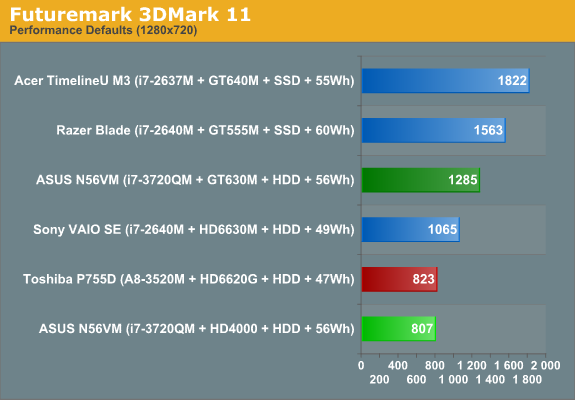
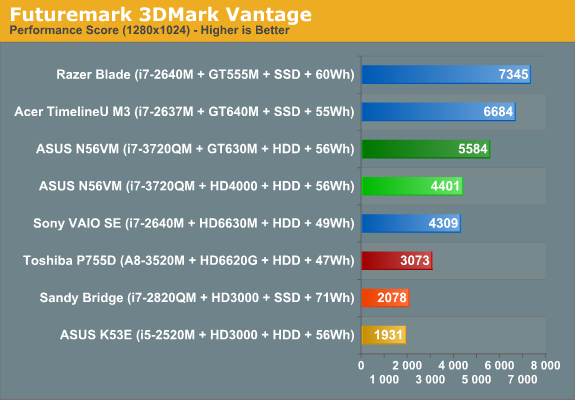
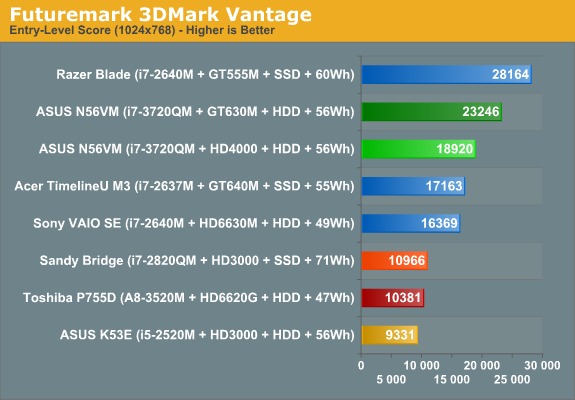
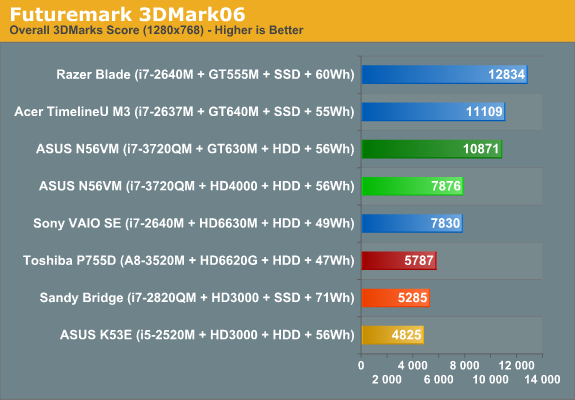
As noted earlier, Ivy Bridge appears to be more about graphics than CPU performance, and we get a taste of that by looking at the 3DMark results. If games actually echo what we’re seeing with 3DMark, Ivy Bridge’s HD 4000 is set to marginalize anything below the level of AMD’s HD 6630M or NVIDIA’s GT 525M. In some cases, we even see over a 100% improvement relative to the Sandy Bridge i7-2820QM (e.g. 3DMark Vantage), and now Intel is actually able to run the DX11-required 3DMark 11. 3DMark06 appears to be a more likely scenario, however, with performance about 50% higher than Sandy Bridge and even higher than Llano A8 at times. But then, we all know how much 3DMark means when it comes to actual gaming, right? So let’s move on to the gaming benchmarks.










49 Comments
View All Comments
JarredWalton - Tuesday, May 1, 2012 - link
Ivy Bridge is technically capable of supporting three displays, but it needs three TMDS transceivers in the laptop (or on the desktop motherboard) to drive the displays simultaneously. Some laptop makers will likely save $0.25 or whatever by only including two, but others will certainly include the full triple head support.JarredWalton - Thursday, May 10, 2012 - link
Just a quick correction, in case anyone is wondering:For triple displays, Ivy Bridge needs to run TWO of the displays off of DisplayPort, and the other can be LVDS/VGA/HDMI/DVI. I can tell you exactly how many laptops I've seen with dual DP outputs: zero. Anyway, it's an OEM decision, and I'm skeptical we'll see 2xDP any time soon.
JarredWalton - Tuesday, April 24, 2012 - link
"I'm not sure what your point is, at all"? You cannot be serious. Either you have no understanding of thermodynamics, or you're just an anonymous Internet troll. I don't know what your problem is, rarson, but your comments on all the Ivy Bridge articles today are the same FUD with nothing to back it up.Ivy Bridge specifications allow for internal temperatures of up to 100C, just like most other Intel chips. At maximum load the chip in the N56VM hits 89C, but it's doing that with the fan hardly running at all and generating almost no noise compared to other laptops. Is that so hard to understand? A dual-core Sandy Bridge i7-2640M in the VAIO SE hits higher temperatures while generating more noise. I guess that means Sandy Bridge is a hot chip in your distorted world view? But that would be wrong as well. The reality is that the VAIO SE runs hot and loud because of the way Sony designed the laptop, and the N56VM runs hot and quiet because of the way ASUS designed the laptop.
The simple fact is Ivy Bridge in this laptop runs faster than Sandy Bridge in other laptops, even at higher temperatures than some laptops that we've seen. There was a conscious decision to let internal CPU temperatures get higher instead of running the fans faster and creating more noise. If the fan were generating 40dB of noise, I can guarantee that the chip temperature wouldn't be 89C under load. Again, this is simple thermodynamics. Is that so difficult to understand?
How do we determine what Ivy Bridge temperatures are like "in general"? How do you know that it's a "hot chip"? You don't, so you're just pulling stuff out of the air and making blanket statements that have no substance. It seems you either work for AMD and think you're doing them a favor with these comments (you're not), or you have a vendetta against Intel and you're hoping to make people in general think Ivy Bridge is bad just because you say so (it's not).
mtoma - Tuesday, April 24, 2012 - link
I really don't want to play dumb - but if I get an honest answer I'll be pleased: Jarred said that the panel used in Asus N56VM is an LG LP156WF1. OK - how can I find the display type in a specific laptop? I have a Lenovo T61 and... I need help. I want to know the manufacturer, display type, viewing angles. Thanks!JarredWalton - Tuesday, April 24, 2012 - link
I use Astra32 (www.astra32.com), a free utility that will usually report the monitor type. However, if the OEM chooses to overwrite the information in the LCD firmware, you'll get basically a meaningless code. You can also look at LaptopScreen.com and see if they have the information/screen you need (http://www.laptopscreen.com/English/model/IBM-Leno...leovande321 - Wednesday, May 15, 2013 - link
AUO 10.1 "SD + B101EVT03.2 1280X800 Matte Laptop Screen Grade A +I hope to help you!!!
AUO BOE CMO CPT IVO 10.1 14.0 15.6 LED CCFL whoalresell
Wholesale Laptop Screens www.globalresell.com
Spunjji - Thursday, April 26, 2012 - link
Calm down there. His comment is pointing out that measuring the temperatures of this laptop will tell you nothing about how hot mobile Ivy Bridge is as a platform. We need more information. It looks like it's not as cool as Intel marketing want everyone to believe, but we just don't know yet.JarredWalton - Thursday, April 26, 2012 - link
The real heart of the matter is that more performance (IVB) just got stuffed into less space. 22nm probably wasn't enough to dramatically reduce voltages and thus power, so the internal core temperatures are likely higher than SNB in many cases, even though maximum power draw may have gone down.For the desktop, that's more of a concern, especially if you want to overclock. For a laptop, as long as the laptop doesn't get noisy and runs stable, I have no problem with the tradeoff being made, and I suspect it's only a temporary issue. By the time ULV and dual-core IVB ship, 22nm will be a bit more mature and have a few more kinks ironed out.
leovande321 - Wednesday, May 15, 2013 - link
AUO 10.1 "SD + B101EVT03.2 1280X800 Matte Laptop Screen Grade A +I hope to help you!!!
AUO BOE CMO CPT IVO 10.1 14.0 15.6 LED CCFL whoalresell
Wholesale Laptop Screens www.globalresell.com
raghu78 - Wednesday, May 2, 2012 - link
Even though you have mentioned that 45w Llano would have improved the gaming performance it would have been better to include such a configuration in your testing. Given that you were testing a 45w high end next gen core i7 product which itself skews the balance in Intel's favour given the vast difference in CPU processing capability the least you could have done was put a similar wattage AMD Llano SKU. The result would be that other than Batman and Skyrim the rest would all be better on HD 6620G. As they say "a picture is worth a thousand words ". All your charts cannot be undone by a small note at the end of the charts. The damage has been done.This is my opinion that objective comparisons can only be made under similar parameters. Its even more critical in the notebook market which have strict thermal restrictions. The desktop market is slightly less restrictive except for HTPCs which need 65w or lesser processors. When the comparisons for Trinity 35w are made it should be against 35w Ivybridge core i3 and core i5. By benching a ivybridge core i7 with a 45w rating and comparing with a Trinity 35w we aren't making a fair and objective comparison. Also the fact that the ivybridge core i7 and trinity are not in the same price segment makes things worse. I hope my comments are not taken negatively.